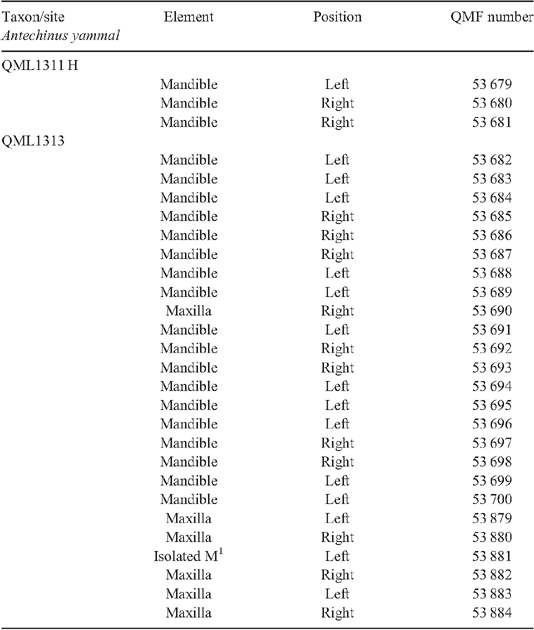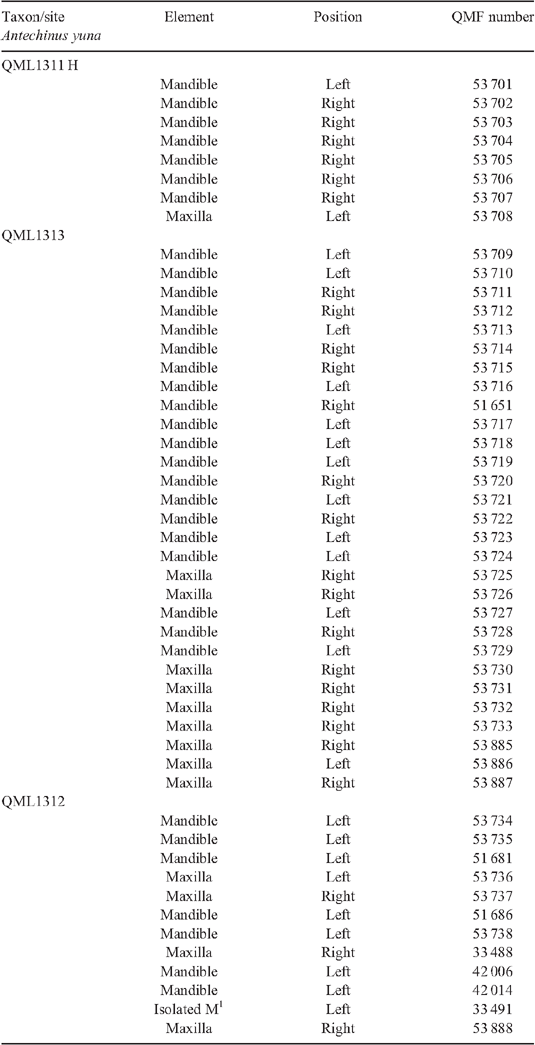Two new species of Antechinus Macleay (Dasyuridae : Marsupialia) from mid-Pleistocene cave deposits in eastern central Queensland
Jonathan Cramb A C and Scott Hocknull BA Queensland University of Technology, GPO Box 2434, Brisbane, Qld 4001, Australia.
B Geosciences, Queensland Museum, Brisbane, Qld 4000, Australia.
C Corresponding author. Email: j2.cramb@student.qut.edu.au
Australian Mammalogy 32(2) 127-144 https://doi.org/10.1071/AM09025
Submitted: 10 October 2009 Accepted: 1 April 2010 Published: 5 August 2010
Abstract
The dasyurid genus Antechinus occurs in numerous Cainozoic fossil sites but until now only one extinct species has been described, Antechinus puteus Van Dyck. Antechinus yammal sp. nov. and A. yuna sp. nov. are described here on the basis of dental remains recovered from middle Pleistocene (between >500 and 205–170 thousand years ago) cave deposits at Mount Etna, eastern central Queensland. Most of these sites are interpreted as closed rainforest palaeoenvironments, and this is the likely habitat of both species.
Both taxa are morphologically variable. A. yammal is characterised by complete anterior cingula and well developed posterior cingula on the upper molars; a relatively unreduced, robust P3; and small entoconids. A. yuna is a relatively large species, typified by poorly developed or absent posterior cingula on M1–3, lack of a metacone on M4, and large entoconids on M1–3. Dental morphology suggests that A. yuna was a near relative of the extant A. leo. The dentition of A. yammal shows some similarities to that of A. flavipes, but its exact phylogenetic position is unclear. A. yammal became extinct coincident with the loss of its rainforest habitat some time between 280 and 205–170 thousand years ago. A. yuna survived somewhat longer, but by the late Pleistocene had been replaced by A. flavipes.
Additional keywords: Antechinus yammal, Antechinus yuna, dasyurid, Mount Etna, Pleistocene
Acknowledgements
The authors thank Gregory E. Webb for comments on the manuscript, Heather Janetzki, Steve Van Dyck and Sandy Ingleby for access to comparative material and the staff and volunteers at the Queensland Museum Geosciences Laboratory who assisted with sample preparation. Work at Mt Etna has been assisted by Cement Australia, the Sands family, the Central Queensland Speleological Society, Capricorn Caves, and Rockhampton Regional Development. Special thanks to two anonymous reviewers, whose comments greatly improved the quality of the paper. Research was funded by Australian Research Council grants LP0453664 and ARC LP0989969.
Archer, M. (1981). Results of the Archbold Expedition; No. 104, Systematic revision of the marsupial dasyurid genus Sminthopsis Thomas. Bulletin of the American Museum of Natural History 168, 63–223.
Benton, M. J. , and Pearson, P. N. (2001). Speciation in the fossil record. Trends in Ecology & Evolution 16, 405–411.
| Crossref | GoogleScholarGoogle Scholar |
Dawson, L. , Muirhead, J. , and Wroe, S. (1999). The Big Sink Local Fauna: a lower Pliocene mammalian fauna from the Wellington Caves complex, Wellington, New South Wales. Records of the Western Australian Museum Supplementary Series 57, 265–290.
Hall, S. (1980). The diets of two coexisting species of Antechinus (Marsupialia: Dasyuridae). Australian Wildlife Research 7, 365–378.
| Crossref | GoogleScholarGoogle Scholar |
Krajewski, C. , Torunsky, R. , Sipiorski, J. T. , and Westerman, M. (2007). Phylogenetic relationships of the dasyurid marsupial genus Murexia. Journal of Mammalogy 88, 696–705.
| Crossref | GoogleScholarGoogle Scholar |
Lundelius, E. L. J. , and Turnbull, W. D. (1978). The mammalian fauna of Madura Cave, Western Australia. Part III. Fieldiana: Geology 38, 1–120.
Simpson, G. G. (1930). Post-Mesozoic Marsupialia. Fossilium catalogus Animalia 1, 1–87.
Thomas, O. (1904). On a collection of mammals made by Mr J. T. Tunney in Arnhem Land, Northern Territory of South Australia. Novitates zoologicae 11, 222–229.

Thomas, O. (1923). The Godman Exploration Fund: list of mammals from north Queensland collected by Mr T. V. Sherrin. The Annals and Magazine of Natural History 9, 170–178.

Turnbull, W. D. , Lundelius, E. L. , and Archer, M. (2003). Dasyurids, perameloids, phalangeroids, and vombatoids from the Early Pliocene Hamilton Fauna, Victoria, Australia. Bulletin of the American Museum of Natural History 279, 513–540.
| Crossref | GoogleScholarGoogle Scholar |

Van Dyck, S. M. (1980). The cinnamon antechinus, Antechinus leo (Marsupialia: Dasyuridae), a new species from the vine-forests of Cape York Peninsula. Australian Mammalogy 3, 5–17.

Van Dyck, S. (1982). Antechinus puteus (Marsupialia, Dasyuridae), a new fossil species from the Texas Caves, southeastern Queensland. Australian Mammalogy 5, 59–68.

Van Dyck, S. (2002). Morphology-based revision of Murexia and Antechinus (Marsupialia: Dasyuridae). Memoirs of the Queensland Museum 48, 239–330.

Van Dyck, S. , and Crowther, M. S. (2000). Reassessment of northern representatives of the Antechinus stuartii complex (Marsupialia: Dasyuridae): A. subtropicus sp. nov. and A. adustus new status. Memoirs of the Queensland Museum 45, 611–635.

Waterhouse, G. R. (1838). Characters of some new species of the genera Mus and Phascogale. Proceedings of the Zoological Society of London 1837, 75–77.

Waterhouse, G. R. (1840). Description of a new marsupial mammal, belonging to the genus Phascogale. Magazine of Natural History 4, 299–301.

Wroe, S. (1999). The geologically oldest dasyurid, from the Miocene of Riversleigh, north-west Queensland. Palaeontology 42, 501–527.
| Crossref | GoogleScholarGoogle Scholar |


|

|


